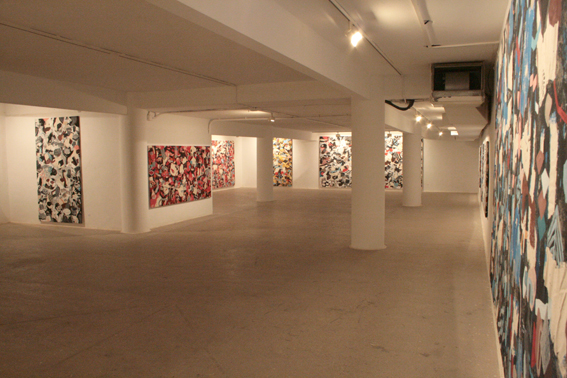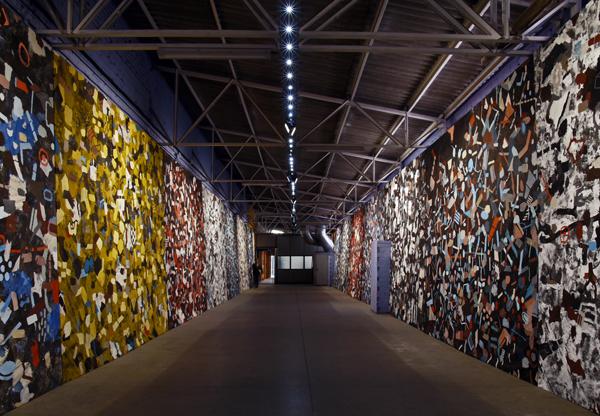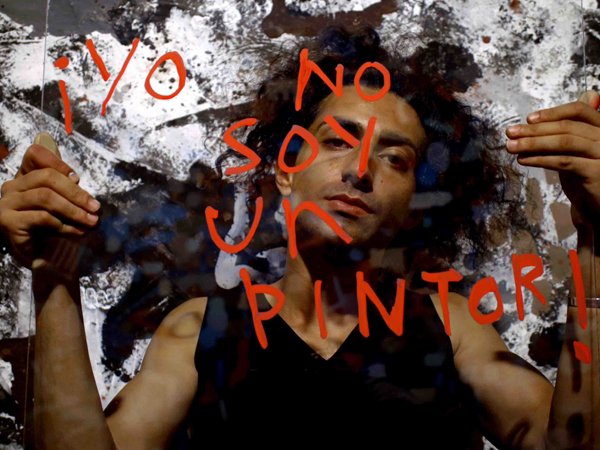2007
“MI VERTIGO” PAINTINGS AND TONI CALDERON TEXT
Volkan Diyaroglu. Mestizaje y sincretismo.
“el lienzo es un campo de juego en el que reproducir, rediseñar, analizar o expresar un objeto real o imaginario”
Harold Rosemberg
La obra del joven artista turco afincado en París Volkan Diyaroglu es mucho más que pintura. Para Volkan el proceso, las dimensiones y el espacio forman parte de su trabajo. Si su trabajo se analiza desde un punto estrictamente pictórico se evidencian claras similitudes con artistas universales del arte contemporáneo, en concreto, con los creadores de la “action painting” de los años cincuenta y también con la pintura renovada de principios de los ochenta o lo que es lo mismo, con el expresionismo abstracto de Jackson Pollock o la nueva pintura cuyo máximo exponente es Jean Michel Basquiat. Estas influencias, a priori, pueden definir a Volkan como un artista ecléctico en el sentido literal de la palabra, lo que no presume entenderlo en sentido peyorativo, pues el arte progresa y se anticipa cuando es capaz de conjugar pasado y presente a la hora de recorrer nuevos caminos.
“DELIK” PAINTINGS AND JOSE MIR TEXT
It is well know that art isn’t produced in a vacuum, that no artist is independent of his predecessors and models, and stemming from a specific tradition. In contemporary art, the paintings of Volkan Diyaroglu have parallels with historical vanguards as well as the legendary painters of the eighties, with references to gesture painting, to the action painters of the fifties such as Jackson Pollock, the art brut of Dubuffet and, closer to home, George Mathie or Jean Michel Basquiat, among others.
Nevertheless, a false sense of deja-vu shouldn’t influence the perception of the artist’s canvases in the least. One can appreciate how he immersed himself in his influences, both formal and those of process, to create experimental and free paintings whose borders continuously move in intuitive fountain of unlimited creativity. The elements are hybrids rather than pure, confused rather than clear, perversely indeterminate, elements that show the artist as a clear and individual personality.
“DELIK” PAINTINGS AND INTERVIEW WITH TONI CALDERON
Interview a Volkan Diyaroglu.
Toni Calderón. What role does painting have in an art world dominated by digital technologies?
Volkan Diyaroglu. In the first place, we have to look at ourselves and ask what role do the new digital technologies have in our lives and question what role we ourselves play. Do we have control over our lives? I would answer no. In no aspect of our life do we exercise the control that we should, and what’s more, at present digital technology dominates us rather than we dominating it. We’re under a dictatorial power and unable to decide the rhythm of our lives, which in a certain sense is absurd.
I would say that we are swept along in a wild, swirling river where each individual is looking for his place, complicated by swimming against the current. I believe that this structure destroys artistic creation from the start. I’m not saying that we shouldn’t accept new developments; on the contrary, we have to accept it with a wide understanding and ability to see what things have in common and what their differences are. No just looking at surface appearances, but digging a bit deeper.
For me, painting is just painting, no more no less, like poetry – it’s that simple. Asking questions is fine, but one also has to be able not to understand and to continue asking. And if I have to talk about the use of the new digital technologies in art, millions of questions are raised in my mind. Why does something painted in a computer with a 3d programme and then printed on a clean and shiny surface, or a photograph have to be any different than a painting? Or why is a painting any different than, for example, a cup o an apple? I think that what we’re left with is that they simply exist. Personally, I think that before looking at any technical questions, we should look at the context. The truth is that never has it been as difficult to be a painter in a society that moves along to the rhythm of what’s in fashion, like postmodern cannibals, and then run quickly to another objective, thereby creating a disorderly circulation of our own individual selves that is very dangerous, seemingly ordered but subordinate to power and the system.
Nonetheless, I think that never has painting, as we ourselves are, been so interesting, immersed in increasingly complex societies. Bit by bit, the new technologies are distancing humans from their own physical being, converting them into an object of consumption. I like and hate painting for the slow rhythm and its relationship with my physical body. I’m more interested in the time I spend while I paint than the finished work ready to be consumed by the spectator, although the finished result also interests me, but to a lesser degree. But who is to say that painting isn’t another new technology? Every day, I invent a new technology in my painting though I don’t tell anyone about it; it’s a secret surprise for myself and for those, who like me, don’t fit into this world. My paintings are there, as I said, like a table that is now before me, quiet and silent, and in the end I think that painting simply has the role of painting, just as we play the role of ourselves at the same time.





